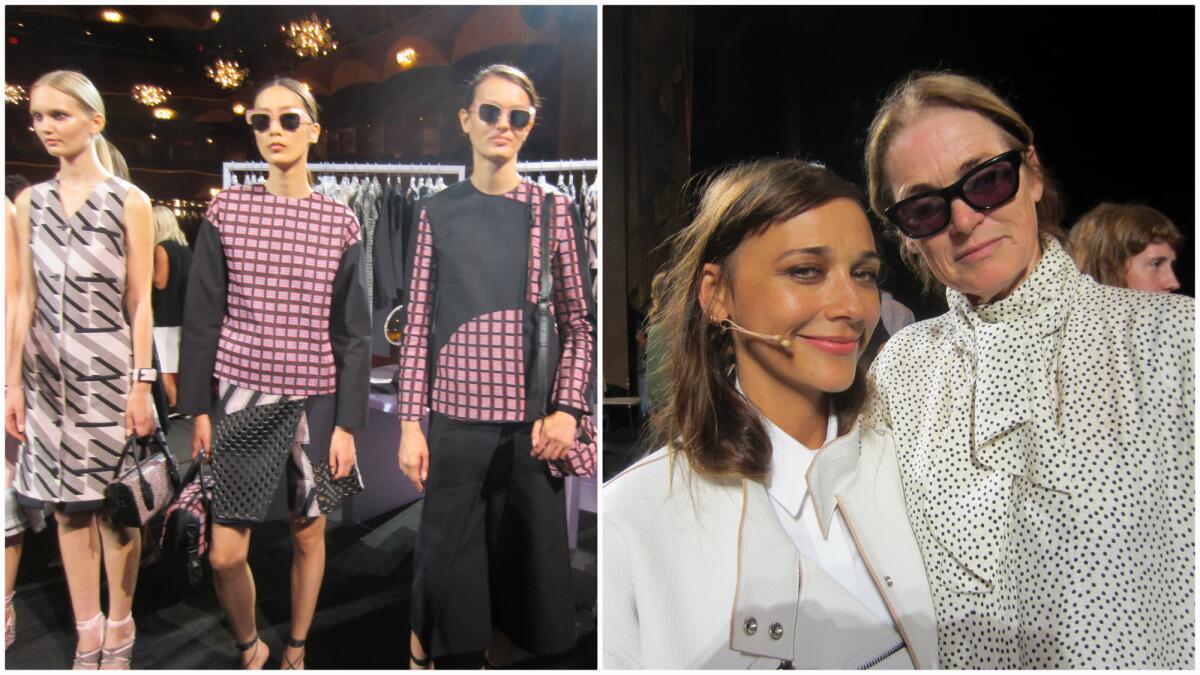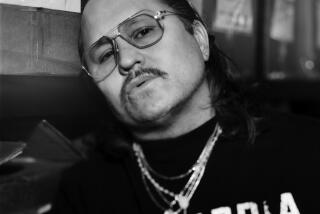New York Fashion Week: Opening Ceremony play rekindles the magic

Reporting from New York — Spike Jonze and Jonah Hill would seem an unlikely duo to make one fall back in love with the bi-annual dog and pony show known as New York Fashion Week – an arcane, mostly outmoded ritual showcasing the possible wardrobe choices of six months hence.
But they, with a supporting cast that included Bobby Cannavale, Catherine Keener, Elle Fanning, Rashida Jones and John Cameron Mitchell, did just that with “100% Lost Cotton,” a roughly 45-minute-long one-act play Sunday night – at the Metropolitan Opera House no less – that managed to be both hilariously industry-skewering and poignantly heartfelt. It also did a bang-up job of presenting Opening Ceremony’s spring and summer 2015 women’s collection in a way that won’t soon be forgotten by anyone in attendance.
(Making it even more special was the fact that all phones had to be turned off, photos were not permitted and everyone sat quietly for the duration of the play.)
Co-written by Jonze and Hill and directed by Jonze, the play focuses on a model casting and fittings for an upcoming runway show, with over-the-top versions of Opening Ceremony founders Humberto Leon and Carol Lim played to over-the-top perfection by Mitchell (“Hedwig and the Angry Inch”) and Keener (“Being John Malkovich”) respectively. Rounding out the cast, with a mostly mute tableaux of collection-wearing models in the background, were Cannavale as a stylist named Brian; Fanning as a newbie model named Julie; actress Dree Hemingway (“While We’re Young”) as a jaded slightly older model named Bella; Rashida Jones (“Parks and Recreation”) as Vogue West Coast editor Lisa Love; actress Alia Shawkat (“Arrested Development”) as beleaguered assistant Dylan; and supermodel Karlie Kloss as, well, supermodel Karlie Kloss.
Set in a fictional universe (“which also happens to borrow our names,” Leon and Lim write in a Playbill-like booklet accompanying the show) the story touches on the topics of love, friendship and the frenetic pace of the creative process, which, as it unfolds, provides ample opportunity to study looks from the spring and summer 2015 collection. It was a fashion show after all – remember?
You’d be forgiven if you’d given up the ghost on that front altogether. And credit goes to the playwrights who have Dree telling the coltish Fanning “I also do musing. It’s like when a designer looks at you to get ideas.”
Mitchell’s Humberto is in a near constant fit of pique at the models. “We don’t do the open-mouth walk,” he says to Brian at one point, “Tell her to do a close-mouth walk.” At another fitting he recoils in horror. “Her legs are making this skirt look terrible,” he shrieks. “Can we get her new legs?” After trying in vain to add a “baby bag” (i.e. a smallish handbag) to one model’s look he issues a decree “to remove the right sleeve from every T-shirt and rib knit.”
Over the course of the play we find out that Brian is secretly in love with Humberto’s husband, Bella becomes disenchanted with her model life, Julie fawns over Karlie’s supermodelish life and Carol careens back and forth across the stage cursing like a stevedore.
And just at that very second the fashion writer inside the theater patron wakes up and looks at his empty notepad, Jones’ Lisa Love enters stage left – pen and pad in hand – to save the day. A deft bit of exposition later and details of the collection are well in hand (if not in head) and the play/presentation (“playsentation”?) could continue apace.
“This spring-summer is about color,” Humberto tells Love, “it’s also about print. … it’s pre-Internet and post-nostalgia, post-punk, pre-grunge and totally pre-Twitter.”
A short time later he adds that it’s specifically a nod to the summer of ’91 when Leon and Limfirst met and they’d sit around trying to figure out what pools to crash. “I’d go over to her house and she’d let me dress her up in wild [stuff], she let me do that because she knew that however I dressed her was how I was feeling that day. … It was just fun, there was no pressure, there was no deadlines, the biggest decision we would have to make that day was what flavor Jolly Rancher we were going to get at 7-Eleven, you know?”
The playsentation collection included a range of simple black and white dresses, tops, skirts and trousers, some with oblong grommets, others with cut-out ellipsis, allover-print rompers and skirts and a range of bold graphics – grids, ribbons and bars -- straight out of the ‘90s as well as a couple that could’ve been made on a Macintosh II. The color palette included blacks, whites, pale greens and pinks.
Jumping back into plot land, Humberto and Brian open up to each other, Bella gives Julie her “why fashion matters” speech and Julie solves the final creative conundrum facing the crew – what song to pick for the runway show finale. The play ends with a big musical number – warbled to a start by the sweet, innocent Julie (all Fanning’s pure-heart routine was missing was a cartoon halo of chirping bluebirds) and the initiation to the audience, which had been seated in what’s usually the backstage area, to exit by walking up and across the stage and through the theater proper, mingling with the models and the cast along the way.
At first blush it may seem like a bit of a self-indulgence – and hardly an efficient way to showcase the clothes they’re selling, but we kept careful count of the number of looks and how long they were on stage. Between that, the 33 full-color photographs of the looks on models stapled into the faux-playbill and the opportunity to examine the clothes up close on egress, it actually afforded more time not less.
In an era of smartphones, fashion bloggers, Instagram and Twitter, the traditional New York Fashion Week runway show experience has become democratized so completely and can be disseminated so quickly, that what was once magical has become mundane. To borrow a phrase from the world of television programming, the “water cooler moments” are few and far between.
Sunday night at the Metropolitan Opera was assuredly one of those moments. “Lost Cotton” helped us find renewed faith in the transformative power of fashion.
What it will do for Opening Ceremony’s spring summer 2015 collection remains to be seen.
But for at least one night, for all involved, that hardly seemed to matter.
For the latest in fashion and style news, follow me @ARTschorn







